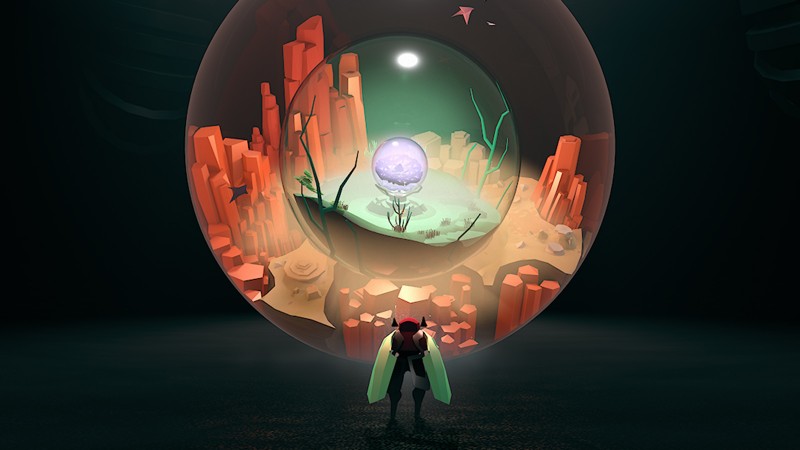The abstract environmental puzzle game has become its own genre in recent years, with some telling stories that are strange but easy to parse and others being so opaque that the player can ascribe almost any meaning to what is transpiring on screen. On this difficult-to-define spectrum, Cocoon lands on the latter half of the scale. I basically never had any idea why I was doing what I was doing or what the larger goal was, but I didn’t mind for a moment because the puzzles scratch your brain so effectively that I was always eager to complete whatever strange task it put in front of me.
In Cocoon, you are a winged bug creature with limited flight abilities who must move marble-like globes from point to point. Simply moving the protagonist around the world feels fantastic, and engaging with the world is simple. You don’t jump or attack enemies. Every interaction is handled with one button. The fluidity of movement and simplicity of engagement leave you to fully concentrate on the puzzle task and take in the always impressive animation of the environment and various creatures that inhabit it.
The core hook of Cocoon is the globes your character can pick up and move. Each globe contains a world within it, and the process of moving through the game and solving its puzzles involves jumping into and out of these worlds, taking advantage of the abilities they offer while you hold them. The orange globe, for example, makes certain paths appear, and the green globe lets you move up and down certain platforms. The puzzle-solving emerges from figuring out how to carry the globes you need into the correct worlds. Cocoon impressively manages this potentially brain-breaking puzzle mechanic without ever getting too complicated and making you feel like you’re climbing deeper and deeper into an ever-shrinking series of worlds.
The one frustration from this process is that solving a puzzle often builds to knowing where and how you need to position your globes and carrying them one at a time to their destination. Thankfully, it never gets too tedious, but there are a few instances where I felt I was going through a motion to finish a puzzle as opposed to arriving at a moment of brilliant catharsis.
Despite the abstract art direction, which pushes you through a series of strange, seemingly organic structures, I never found myself in a position where I wasn’t sure which direction I needed to go. Environmental clues, or the occasional key that floats alongside you, help tell you which direction to head toward. I always felt like I was making progress and never banging my head against a puzzle I didn’t understand.
A few boss fights break up the puzzle-solving, and I always looked forward to meeting them. It is in these instances where the experience gets closest to resembling an action game. You’re not so much attacking an enemy in the traditional sense but rather making sure to be in the right position until they are defeated. I enjoyed the challenge of every boss encounter and breaking down how to overcome them.
Perhaps Cocoon’s biggest triumph is its pace and how well it hands out new globe-based abilities all the way up to the end. The game excels at making you an expert on how to use a specific ability to solve a puzzle and then continue to use that ability in tandem with the new ones you’ve discovered. World-hopping certainly has the potential to get over-complicated, but Cocoon shows restraint in the interest of creating a better puzzle game, and it pays off. I don’t know that I will ever fully understand what transpired during my molecular journey on Cocoon’s alien world, but its imagery and puzzles will stay with me for some time.
Products In This Article
Cocoon
Source: Read Full Article




















